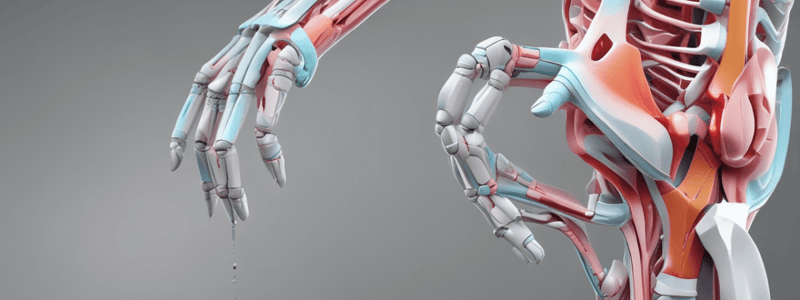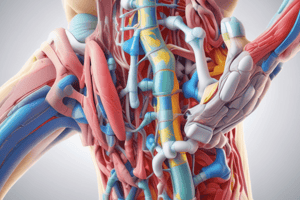Podcast
Questions and Answers
Passive Range Of Motion (ROM) refers to movements generated by the individual's own muscles.
Passive Range Of Motion (ROM) refers to movements generated by the individual's own muscles.
False (B)
The physiological barrier is located at the middle range of motion.
The physiological barrier is located at the middle range of motion.
False (B)
Degrees of freedom represent the number of independent movements allowed at a joint.
Degrees of freedom represent the number of independent movements allowed at a joint.
True (A)
Spin in osteokinematics refers to movement back and forth around a fixed pivot point in multiple planes.
Spin in osteokinematics refers to movement back and forth around a fixed pivot point in multiple planes.
Impure swing involves pure rotation around another axis.
Impure swing involves pure rotation around another axis.
Joint play is increased when ligaments and capsules are relatively taut.
Joint play is increased when ligaments and capsules are relatively taut.
Active Range Of Motion (ROM) requires external force by a therapist to move one articular surface on another.
Active Range Of Motion (ROM) requires external force by a therapist to move one articular surface on another.
Squeezing out of fluid during joint compression has a negative effect on joint nutrition.
Squeezing out of fluid during joint compression has a negative effect on joint nutrition.
The study of the classification, structure, and function of joints is an important foundation for the overall study of kinesiology.
The study of the classification, structure, and function of joints is an important foundation for the overall study of kinesiology.
Detailed information about joint structure and function is not a prerequisite for understanding joint impairments and effective rehabilitation.
Detailed information about joint structure and function is not a prerequisite for understanding joint impairments and effective rehabilitation.
The design of a joint depends solely on the function of the joint.
The design of a joint depends solely on the function of the joint.
Joints with the main function of stability will have a different design than joints with the main function of mobility.
Joints with the main function of stability will have a different design than joints with the main function of mobility.
Synarthroses are joints that allow no movement between the bones.
Synarthroses are joints that allow no movement between the bones.
The design of a joint becomes less complex as functional demands increase.
The design of a joint becomes less complex as functional demands increase.
Joints can be classified based on their potential for movement.
Joints can be classified based on their potential for movement.
Arthrokinematics and osteokinematics are not important topics in the study of joint structure and function.
Arthrokinematics and osteokinematics are not important topics in the study of joint structure and function.
Accessory motion is under voluntary control and can be tested by the application of an external force.
Accessory motion is under voluntary control and can be tested by the application of an external force.
If the joint structures are tight, the joint will have too much play and become unstable.
If the joint structures are tight, the joint will have too much play and become unstable.
For a convex-on-concave surface movement, the convex member rolls and slides in the same directions.
For a convex-on-concave surface movement, the convex member rolls and slides in the same directions.
In a saddle shape joint, the combined movements involve roll-and-slide.
In a saddle shape joint, the combined movements involve roll-and-slide.
In a ball and socket joint, the combined movements involve roll-and-slide and spin.
In a ball and socket joint, the combined movements involve roll-and-slide and spin.
Abduction without a concurrent inferior slide causes the humeral head to impinge against the arch and block further abduction.
Abduction without a concurrent inferior slide causes the humeral head to impinge against the arch and block further abduction.
The knee joint is relatively externally rotated when fully extended.
The knee joint is relatively externally rotated when fully extended.
In the close-packed position, the joint is in a position of maximal natural structural stability and is resistant to tensile forces that tend to cause distraction (separation) of the joint surfaces.
In the close-packed position, the joint is in a position of maximal natural structural stability and is resistant to tensile forces that tend to cause distraction (separation) of the joint surfaces.
Fibroblasts are found in ligaments and tendons.
Fibroblasts are found in ligaments and tendons.
Chondrocytes are found in hyaline and fibrocartilage.
Chondrocytes are found in hyaline and fibrocartilage.
Dense connective tissue contains a high content of ground substance.
Dense connective tissue contains a high content of ground substance.
The collagen fibers in tendons are oriented in a single direction.
The collagen fibers in tendons are oriented in a single direction.
Ligaments have slack fibers oriented in multiple directions.
Ligaments have slack fibers oriented in multiple directions.
Articular cartilage covers the ends of articulating bones in synovial joints.
Articular cartilage covers the ends of articulating bones in synovial joints.
The collagen fibers in articular cartilage are of type I.
The collagen fibers in articular cartilage are of type I.
Dense connective tissue has a high metabolism due to its rich blood supply.
Dense connective tissue has a high metabolism due to its rich blood supply.
Bone is a specialized connective tissue.
Bone is a specialized connective tissue.
The outer cortex of bone is porous and cancellous.
The outer cortex of bone is porous and cancellous.
Bone fibers are made of highly cross-linked type I collagen.
Bone fibers are made of highly cross-linked type I collagen.
The ground substance in bone has a high content of glycosaminoglycans (GAGs).
The ground substance in bone has a high content of glycosaminoglycans (GAGs).
Osteocytes are the cells found in bone tissue.
Osteocytes are the cells found in bone tissue.
Bone has a poor potential for healing.
Bone has a poor potential for healing.
Bone remodeling occurs in response to physical activity and hormonal influences.
Bone remodeling occurs in response to physical activity and hormonal influences.
Bone is strongest against tensile forces.
Bone is strongest against tensile forces.
Viscoelasticity refers to a material's ability to return to its original state after deformation.
Viscoelasticity refers to a material's ability to return to its original state after deformation.
Tissues with high viscosity exhibit low resistance to deformation.
Tissues with high viscosity exhibit low resistance to deformation.
Flashcards are hidden until you start studying
Study Notes
Joint Position and Play
- Joint position refers to the relationship between two adjacent articular surfaces
- Loose-packed (resting) position: ligaments and capsule are relatively slackened, less natural structural stability, and increased joint play
- Close-packed position: maximal congruency, ligaments and capsule are pulled taut, maximal natural structural stability, and resistant to tensile forces
Osteokinematics
- Spin: rotation around a bone's long axis
- Swing: rotation around a joint axis
- Pure swing: movement back and forth around a fixed pivot point in one plane
- Impure swing: secondary movement around another axis
- Degree of freedom (DOF): the number of independent movements allowed at a joint
- 3 translational motions and 3 angular motions
Range of Motion (ROM)
- Active ROM: maximum force in middle range for flexors and inner range for extensors
- Passive ROM: end feel, physiological barrier, and outer range
- Start ROM: 1/3, 1/3, and inner range
- End feel: overpressure at the end of ROM to determine the quality of each passive movement
Bone Structure and Function
- Bone is a specialized connective tissue that resists deformation, provides a rigid lever to transmit muscle force, and allows for dynamic metabolism and good healing potential
- Bone composition: compact and cancellous bone, with a framework of highly cross-linked type I collagen and hard mineral salts
- Haversian canals system allows for a rich source of blood and nerves deep within the cortex
Connective Tissue
- Viscoelasticity: combination of elasticity and viscosity
- Elasticity: a solid material's ability to return to its original state following deformation
- Viscosity: resistance of a fluid to change in shape, measured by the resistance to gradual deformation by shear or tensile stress
Arthrokinematic Principles of Movement
- Convex-concave rule: convex member rolls and slides in opposite directions, while concave member rolls and slides in the same direction
- Combined movements: roll-and-slide, spin, and glide
- Saddle shape joint, ball and socket joint, condyloid or trochoginglymus joint
Dense Connective Tissue
- Anatomic location: most nonmuscular "soft tissues" surrounding a joint
- Fibers: high type I collagen fiber content, parallel fibers in bundles oriented in several directions
- Ground substance: low content
- Cells: fibroblasts, limited blood supply, and low metabolism
Articular Cartilage
- Anatomic location: covers the ends of articulating bones in synovial joints
- Fibers: high type II collagen fiber content, forming a restraining "scaffolding" that adds structural stability
- Ground substance: high content
Joint Structure and Function
- Arthrology: study of the classification, structure, and function of joints
- Objectives: joint design, arthrokinematics, osteokinematics, and properties and functions of materials in human joints
Studying That Suits You
Use AI to generate personalized quizzes and flashcards to suit your learning preferences.




